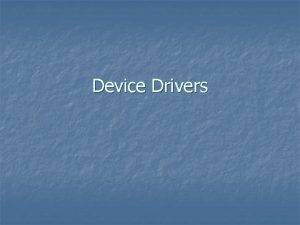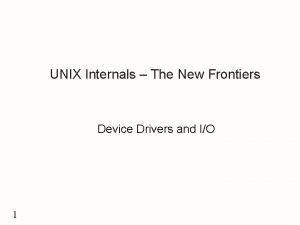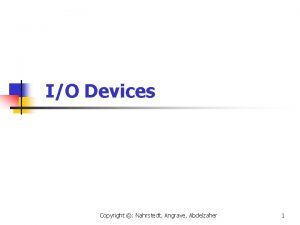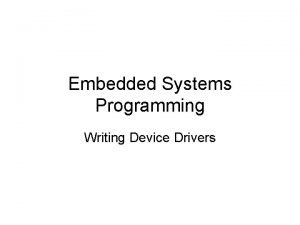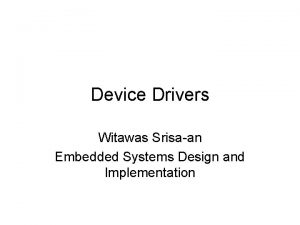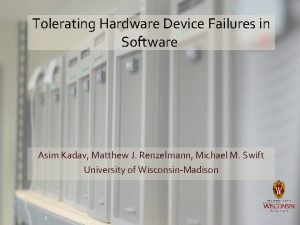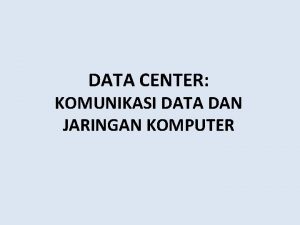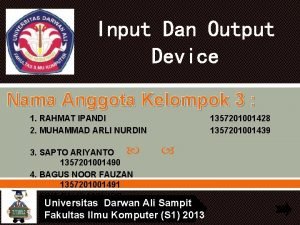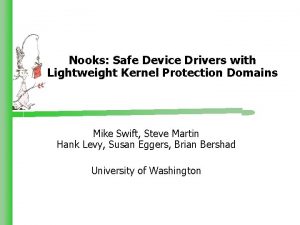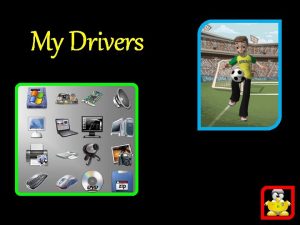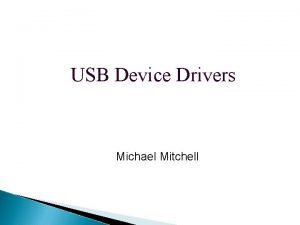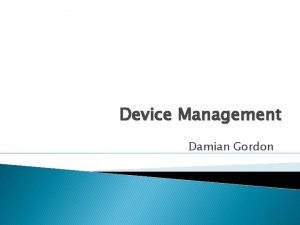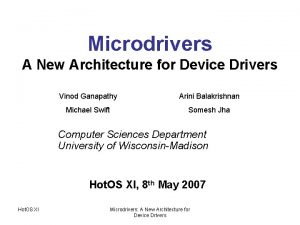Nooks an architecture for safe device drivers Mike






















- Slides: 22

Nooks: an architecture for safe device drivers Mike Swift, The Wild and Crazy Guy, Hank Levy and Susan Eggers

What are the big problems? • Performance? – Solved by Intel • Functionality? – Solved by Microsoft • Scalability? – Solved by Akamai • Reliability? – Solved by Boeing, NASA

Reliability is the problem • When do my parents call me? – When their computer crashes. • Reliability is getting better! – Computers now execute 100 x more cycles between crashes than 10 years ago • But that was on a 486 -33… • But I now have three computers in my office and two at home… • But my computers are on 24 x 7 so I can check the weather faster…

Windows 2000 Failure Analysis. NT 4 Windows 2000 Hardware Anti-virus Failure 12% 13% Other 3 rd Party Kernel code 11% Drivers for HCL HW 7% Drivers for Non. HCL HW 20% Other thirdparty drivers 16% Device drivers 16% Core NT 43% System Config 34% MSInternal. Code 2% Other IFSDrivers 0% Anti-Virus 4% HW Failure 22% Source: Brendan Murphy, Sample from PSS Incidents:

Drivers are the culprit! • 32% of NT 4 faults, 27% of W 2 k faults – Microsoft knows how to fix bugs • Drivers are the bulk of the code in the kernel – Accounts for largest portion of source code – Accounts for large portion of runtime code • Hardware failures make things worse

Why are drivers hard? • • Not written by software companies Challenging programming environment Absolute correctness required Complex asynchronous device protocols

What can we do about it? • There have been past projects on isolating code: – Multics – Microkernels – Mach, L 4, Fluke – Extensible kernels – Spin, Exokernel, Vino – Safe code – SFI, Java • Why not isolate drivers?

Goals • Preserve investment in existing OS – Don’t require rewrite of large portions of kernel • Preserve investments in existing drivers – Allow existing drivers to execute safely with just recompilation • Allow different isolation techniques for different drivers, depending on needs – SFI for low-latency – VM protection for high-throughput

Why is this feasible? • Drivers: – Have a limited interface to kernel – Have limited dependencies from other code – Are designed to be loaded/unloaded independently – Make few performance-critical calls-backs into kernel

How hard is this? • What makes it hard? – Shared state between drivers and kernel – Weak processors • What makes it easy? – Read only parameters – Void functions

Architecture

Optimizations • Defer as much work as possible – Timers are only manipulated when already context switching – Packets are only received when context switching • Provide local resource pools – Local pool of socket buffers, stacks, local heaps

Implementation • Implemented in Linux 2. 4. 10 – 147 call into kernel – 10 interfaces to drivers • File operations, VM operations, network device operations, timers, interrupts … • 103 calls into drivers • Duplicated kernel page table grants drivers readonly access to kernel memory • Lowered privileg level prevents drivers from deadlocking

Wrapping and Protection • Protection domain switch when calling into drivers – Identify all calls to/from kernel – Implement wrapper functions for all calls • Grant drivers read-only access to kernel memory • Trap privileged instructions when running at with lowered privileges

Hacks for evaluation • Don’t run with separate page table – Just flush TLB instead • Don’t run with lowered privileges – Just trap to kernel at appropriate times

Evaluation • Test platform: Blackbox machines – 1. 7 GHz P 4 – 1 GB sdram – Intel PRO/1000 gigabit Ethernet NIC • 200 microsecond round trip time • Configurations – Isolate performance impact of wrapping calls, flushing TLB, trapping to kernel





Ongoing / Future work • Create page table structure for safe drivers on IA-32 • Allow recovery of drivers without full restart – Hardware is idempotent… – Rather than rebooting driver, just retry request

Conclusions • Operating systems should remove their dependence on driver safety • Processors are fast enough spend a little performance on isolation • Existing operating systems can be extended to run existing driver code safely
 Hardware output komputer
Hardware output komputer Safe feed safe food
Safe feed safe food Safe people safe places
Safe people safe places Device drivers meaning
Device drivers meaning Unix internals
Unix internals Dos device drivers
Dos device drivers Functions of device drivers
Functions of device drivers Writing device drivers for embedded systems
Writing device drivers for embedded systems Designing device drivers for embedded systems
Designing device drivers for embedded systems Static detection of unsafe dma accesses in device drivers
Static detection of unsafe dma accesses in device drivers Topologi data center
Topologi data center A tagout device is preferable to using a lockout device.
A tagout device is preferable to using a lockout device. Kelompok output device
Kelompok output device Fspos
Fspos Typiska novell drag
Typiska novell drag Tack för att ni lyssnade bild
Tack för att ni lyssnade bild Returpilarna
Returpilarna Varför kallas perioden 1918-1939 för mellankrigstiden?
Varför kallas perioden 1918-1939 för mellankrigstiden? En lathund för arbete med kontinuitetshantering
En lathund för arbete med kontinuitetshantering Kassaregister ideell förening
Kassaregister ideell förening Tidbok för yrkesförare
Tidbok för yrkesförare Anatomi organ reproduksi
Anatomi organ reproduksi Förklara densitet för barn
Förklara densitet för barn



